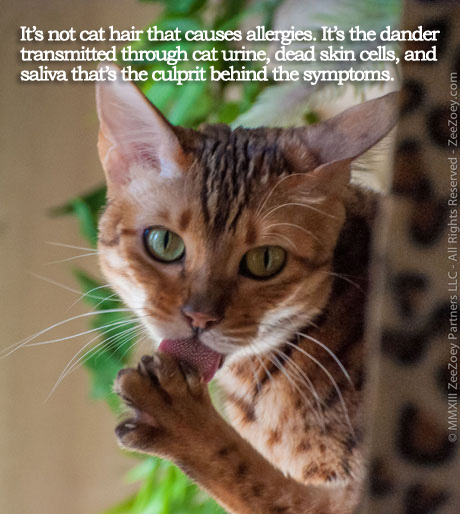Cat Allergies? Don’t Despair – 10 Tips to Manage the Symptoms for Adopt a Shelter Cat Month
 Despite the importance of spay/neuter for cats, not only for their health and well-being but as a humane means to prevent new litters of kittens from being born and entering shelters already overcrowded with cats, the ASPCA estimates 3.2 million cats enter U.S. shelters annually, with approximately 860,000 euthanized because their numbers exceed available adoptees.
Despite the importance of spay/neuter for cats, not only for their health and well-being but as a humane means to prevent new litters of kittens from being born and entering shelters already overcrowded with cats, the ASPCA estimates 3.2 million cats enter U.S. shelters annually, with approximately 860,000 euthanized because their numbers exceed available adoptees.
Cats end up in shelters for numerous reasons, typically because their human guardian surrenders them for behavioral, financial, or personal reasons. One of the most common surrenders is a result of cat allergies, and for June, Adopt A Shelter Cat Month, the good news is, with some patience and preventative measures, many people who are allergic to cats can adopt that feline friend they’ve always wanted, or at the very least, keep the sniffles to a minimum if they already have a cat!

Ironically, it’s not Fluffy’s fur that’s the culprit. Cat allergies are caused by the Fel d 1 protein emanating from sebum found in a cat’s sebaceous glands. The protein attaches itself to dried skin (i.e., dander) which flakes off and floats through the air during grooming. An allergic reaction occurs when the body over-reacts to this substance and produces excessive amounts of histamine which leads to the irritating symptoms associated with cat allergies – itchy eyes, sneezing, and skin rash.
However, before you assume the cat is the source of the allergen, have a skin test done by an allergist because it might not be the cat that is the root cause of the allergy. Outside cats (and humans) can bring plant pollen, mold, and other allergens into the house, or there may be airborne allergens in the house from dust mites, carpet dust, mold spores, or pollen and chemicals in the environment that trigger allergies.
The American College of Allergy, Asthma, has also reported those home fragrances, such as air fresheners, and scented candles can trigger allergy symptoms or exacerbate existing allergies and is a much bigger problem than people realize with about 20 percent of the population and 34 percent of people with asthma reporting fragrance related health problems.
Once the allergy is pinpointed, many sufferers can be successfully treated with allergy shots or over the counter antihistamine tablets, nasal sprays or homeopathic remedies.
If an allergy shot or medication doesn’t do the trick, here are 10 tips to help manage symptoms:
1. Get some fresh air. Highly insulated homes trap allergens, so open windows to increase the ventilation. Just remember to screen windows so kitty stays safely indoors. Also, clean the air inside your home – nothing will remove all the allergens, but strategically placed ionizers and HEPA (High-Efficiency Particulate Air) purifying systems can help reduce dander.
2. Keep towels or throw blankets on couches and furniture where your cat might nap so you can wash the linens frequently, and change air conditioning filters on a regular basis, as they trap a large amount of cat hair. Forced air heating and air conditioning can also spread allergens through the house, so cover vents with dense filtering material like cheesecloth. The use of a deactivating allergen spray throughout the house, such as Allersearch ADS, a product made from plant-based, non-toxic substances, may also be helpful.
3. Carpet is a magnet for allergens, so vacuum frequently with a high-grade HEPA vacuum. Use the hand tools to get into hard to reach spaces – cat allergen particles are very small and invasive, so you must do a thorough job. This includes furniture, throw rugs, drapery, walls, under furniture, and more.
4. Hardwood and tile floors, especially in corners where cat hair tends to drift should be swept frequently. If you find your allergies being triggered while vacuuming or sweeping, wear a protective mask to cover your nose. Damp mopping these surfaces (including walls) also helps keep dander under control. Dust frequently and use liberal amounts of spray furniture polish, as this dramatically limits allergen particles from becoming airborne.
5. Use a vapor steam cleaner for additional protection. They’re an effective method to provide a chemical-free way of killing dust mites, bacteria, mold spores, and dander which are embedded in your carpets and upholstery.
6. Keep your cat out of any bedroom of the person who is allergic and don’t let the cat sleep on the bed. Provide other comfortable sleeping areas for her to nap and if you do allow her to sleep on the bed (for some cat lovers, it’s impossible to say no), wash bedding in 140-degree hot water at least twice monthly. This will eliminate both dust mites and cat allergens and there are products available, such as DeMite, that can safely be used with the laundry detergent to kill harmful particles.
“Keep in mind, isolating a cat from the bedroom, or transitioning to any new environment can be stressful for the cat. Make sure kitty feels safe and comfortable wherever she is, with access to a litter box, food and water dishes, toys, a scratching post, cat bedding and more.”
~Dr. Brittany Lancellotti, Animal Dermatology Clinic, Fear Free Pets Certified~
7. Wash your hands with a strong anti-bacterial soap after petting the cat and avoid rubbing your eyes, as that can result in itchy eyes for hours. You should also avoid excessive hugging and snuggling with the cat and a change of clothes might be necessary to remove lingering dander.
8. Clean your cat. Most cats would prefer NOT to be bathed and its effectiveness isn’t entirely conclusive, as too much bathing may actually dry the cat’s skin, but try Allerpet, a veterinary recommended, easy to use, non-toxic liquid you apply directly to your cat’s coat to reduce allergens.
9. Use a de-shedding tool like the FURminator in a well-ventilated area to regularly brush and groom your cat. The brush is specifically designed to get deep into the undercoat of the cat’s fur, significantly reducing any shedding.
10. Dust from cleaning litter boxes can trigger allergy attacks. Either find someone who is not allergic to do the cleaning or use a protective nose mask to reduce the chances of allergens entering your body.
One, some, or all methods might be needed to keep your allergies under control. But with time, effort, and experimenting, chances are that you and your cat can co-exist peacefully together in your home and you can enjoy a long and happy relationship with your cat. Or, now that you know some tips to make your house allergen-free, you can take the plunge and adopt that cat you always wanted but didn’t think you could have.
ALL cats produce dander, though some cats produce less than others. No cat is allergen-free, not even hairless cats, although there are some studies that conclude Rex, Sphynx, and Siberian Cats are less likely to cause allergies than others. If you do decide to adopt one of these breeds, please consider finding a breed-specific rescue organization or contact Petfinder.com for adoptable cats in your area.





























Ha! Any time The Hubby sneezes, he says, “I’m allergic to cats!”…and then I tell him that he’s just going to have to move out! Luckily, he is NOT allergic, nor am I. But if I were, I’d do whatever it takes to make my furbabies happy, and myself too.
Great tips. I get allergy shots. No allergy would make me part with one of my furbabies even if I sneezed 24/7.
Thank you for sharing these great suggestions — every allergic who diligently practices them should be able to keep their beloved feline family members in their house for life! I advocate for cats needing loving permanent homes on a daily basis, and it causes me a lot of distress each time I see the “allergies” excuse in the profile of a cat whose life is at risk and who desperately seeks a loving forever home. Anything that can be done to stop this is welcomed!
Thanks for pointing out that the allergies may not be toward the cats. I’ve been told several times to get rid of my cats because I’m allergic to them only to be tested and found not to have allergies to cats. Ha! I’d never get rid of them anyway.
Great advice ! The son of a friend of ours is allergic, but he can have a cat (he loves cats ! ) because his mom does the main tips you gave : no carpet, vacuuming every day, mopping often, washing furniture clothes every week, and no cat in his room. And he’s fine ! Purrs
If I had a dollar for every cat being surrendered or rehomed because of “allergies” I could build my own cat sanctuary! The rescue I volunteer with wrote up a guidesheet with instructions like these to give to people who mentioned allergies. Thankfully, many people were willing to follow the protocol and cats kept their homes, but all too often that’s not the case.